On 7 May 2015 I was contacted by Ingrid Bergenstrahle, art collector from Sweden, who had purchased an oil painting in good condition, signed “H Buch 1894”, which measured about 25 by 36 cm with gilded frame about 41 by 51 cm. It was purchased at an auction in Malmö Sweden. The auction house was Lauritz, the largest auction house in Scandinavia. It is where Ingrid Bergenstrahle worked as an expert in jewellery diamonds and old tools from prehistory. Ms Bergenstrahle believed the “H Buch” was Hans Rasmussen Buch, my great grandfather, the father of Hans Buch, the eldest son, who was the father of my father, Douglas Buch, the younger of two brothers –my uncle Henry passed away several decades ago. I never knew either grand or great-grand father, dying before I was born. I am the eldest among my brother and sister. Not that any of the genealogy matters in the way that people generally think it matters.
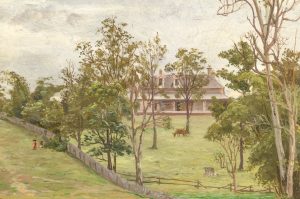
Close up of East Brisbane Painting, depicting Hanworth House, by Hans Rasmussen Buch
What was significant was that it appeared that an early twentieth century minor Queensland artist has had an artwork depicting a local Queensland landscape sold in auction, in good condition, in Scandinavian in the early twentieth-first century. The delight of this discovery is not only the appearance of an artwork half-way-around the world, a century on, but if it is the artwork of Hans Rasmussen Buch, it is a reconnection to the origins of the family, in the region of Rudkjobing on the Isle of Langeland, Denmark.
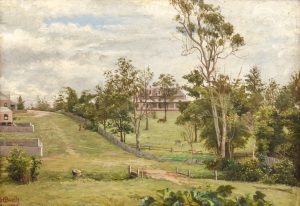
Close up of East Brisbane Painting, depicting East Brisbane ridge from Norman Creek, Hanworth House centre, by Hans Rasmussen Buch
Two tasks were then presented: was the untitled painting from Sweden the work of Hans Rasmussen Buch? And what was the landscape depicted in the painting? The two questions and their answers would reinforce a conclusion. If the landscape depicted was a Queensland location close to where Hans Rasmussen Buch traversed, it would confirm the artist connection to the work. I enlisted the aid of Timothy Roberts, a specialist in Queensland art and decorative art heritage to 1945. Mr Roberts thought that the painting was conceived well and sensitively coloured. Like Ingrid Bergenstrahle’s original assessment, when the painting from the auction house is compared to the known works of Hans Rasmussen Buch, there are strong similarities in the strokes and features. Since there are no documentary ties in the provenance of the artwork found in Sweden, we can only conclude on the weight of affirming evidence that “H Buch” is the Queensland artist Hans Rasmussen Buch. The signature of Hans Rasmussen Buch fits with the basic signature on the painting; the senior Hans tended not to sign his artwork. To date there is no alternative conjectures for the identity of the artist, and thus, further evidence was needed on whether the location of the landscape depicted in the painting could confirm strongly in the direction of Hans Rasmussen Buch.
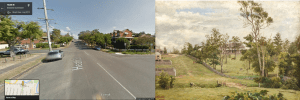
Heath Street Compared
The issue turns on the main distinctive feature in the painting being the homestead on the hill, in a common Queensland style of the era. Tim Roberts believed that it looks like a grand Queenslander with several chimneys and at least two dormer windows, and thought that those featured would narrow down the search for the location. From at least 1896 and for the next two decades, Hans Rasmussen Buch and the family resided in Heidelberg Street, East Brisbane. Discussions with Roy Buch, a senior cousin who has ownership of the other half of the Hans Rasmussen Buch’s art collection, lead us to start to consider the landscape of East Brisbane in the early twentieth century. It was at this point that Tim Roberts suggested that the homestead was Hanworth House, with the perspective of the painting being from a little creek around the modern-day Walter Ave/Real Park area. The painting depicted a view looking up what has become Heath Street. The ditch would be where Clarendon Street is now and the artist’s position would be just in Real Park. At the top of the hill, the gravel street would be Heidelberg. The assistance of East Brisbane historians Geraint and Justeen Gregory were sought.
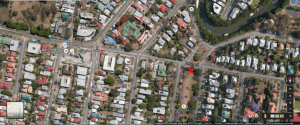
Heath Street Area (painter’s position across from old tributary off the Creek marked)
It was concluded that the landscape image of the painting was 1) the rough match with topography today – the house is on the correct angle to the street as portrayed in the painting, the distance up the hill seems also to match; and 2) the view of the rear of the house in the painting is very similar to Hanworth House.
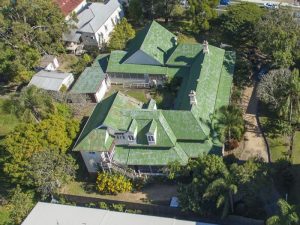
Aerial View Of Hanworth Street
Accepting the thesis of connecting the painting to Hans Rasmussen Buch, a third question comes forth is how the painting came to be in Scandinavia. As Roy Buch points out, who would Hans senior and Louisa (Han’s wife) be sending a painting to in Denmark, since Hans parents already passed away. Roy’s only thought was that the painting could have been sent to Louisa’s mother, Johansine Emilie Andersen. Equally, it might have had something to do with Hans Rasmussen Buch’s role as President of the Danish Association “Heimdal” for 1894-1895 and for 1899-1900.
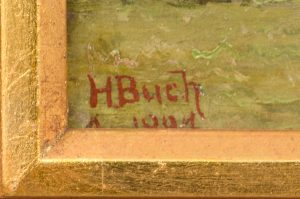
Hans Rasmussen Buch’s signature

